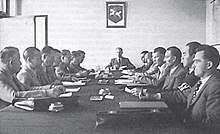Provisional Government of Lithuania

The Provisional Government of Lithuania (Lithuanian: Laikinoji Vyriausybė) was a temporary government aiming for independent Lithuania during the last days of the Soviet occupation and the first weeks of German Nazi occupation in 1941.
It was secretly formed on 22 April 1941, announced on 23 June, 1941, and dissolved on 5 August 1941.[1] It was formed from the members of the Lithuanian Activist Front (LAF) in Kaunas and Vilnius.
History
_newspaper.jpg)
The Provisional Government was confirmed on June 22, at the start of June uprising. However, the leader of the LAF, Kazys Škirpa, who was supposed to become the Prime Minister, was in Germany at the time, hoping to obtain recognition for Lithuania (he was also former Lithuanian envoy to Germany and therefore continued to reside there). Since the Nazi regime saw Lithuania as a future part of Greater Germany, it was not interested in Lithuanian independence. Kazys Škirpa was not allowed to leave Germany and return to Lithuania to join the government; instead, he was put under house arrest. Rapolas Skipitis, another minister to be who also had been in Berlin at the time was prevented from leaving as well.[2]
The Provisional Government strongly opposed the Holocaust carried out by the Nazis, it also tried to rescue the situation and protest.[2][3]
The planned government had other losses as well: Vytautas Bulvičius, who was Minister of Defence, was arrested by the Soviet forces on June 2. His place was therefore taken by General Stasys Raštikis. On June 21, 1941 (just one day before Germany declared war on the Soviet Union), four members of the planned government were arrested by the Soviets: (Vladas Nasevičius, Vytautas Statkus, Jonas Masiliūnas and Jonas Vainauskas); they were imprisoned in Gorky prison in Moscow. The tribunal started on November 26, 1941 (after the uprising had ended, and while Lithuania was still occupied by Germany). Sentences were pronounced on November 28: Bulvičius was executed, while Masiliūnas, Nasevičius, and Statkus were exiled to Siberia, along with other people arrested at the same time.
The government, however, still came to power after the June uprising, and ruled during the June Uprising in Lithuania, until dissolving itself upon the Nazi occupation of the country.[4]
In 1973, the Committee of the United States Congress made unambiguous conclusions that there is no Juozas Ambrazevičius' and Jonas Šlepetys' guilty in the Holocaust in Lithuania.[5][6][7][8]
The cabinet
The people who were meant to be in the government:[9]
- Prime Minister: Colonel Kazys Škirpa (was put under house arrest in Berlin)
- Defense: Major Vytautas Bulvičius (arrested by Russians on June 2, executed in November), later General Stasys Raštikis
- Foreign affairs: Rapolas Skipitis (was not able to leave Berlin)
- Internal affairs: Vladas Nasevičius (arrested by Soviets on June 21, later exiled to Siberia)
- Education: Professor Juozas Ambrazevičius (served as prime minister after Lithuania was liberated in the June uprising)
- Finance: Jonas Matulionis
- Trade: Vytautas Statkus (arrested by Soviets on June 21, later exiled to Siberia)
- Industry: Doctor engineer Adolfas Damušis
- Agriculture: Professor Balys Vitkus
- Social security: Doctor Juozas Pajaujis-Javis
- Infrastructure: Engineer Vytautas Landsbergis-Žemkalnis
- Communication: Jonas Masiliūnas (arrested by Soviets on June 21, later exiled to Siberia)
- Controller of state: Jonas Vainauskas (arrested by Soviets on June 21)
See also
References
- ↑ Jegelevičius, Sigitas (11 June 2004). "1941 m. Lietuvos laikinosios vyriausybės atsiradimo aplinkybės". Voruta (in Lithuanian). 11 (557). ISSN 1392-0677. Archived from the original on May 7, 2006.
- 1 2 "Kuo reikšmingas 1941 m. birželio 22-28 d. sukilimas?". LLKS.lt. Retrieved 20 June 2014.
- ↑ Balčiūnas, J. V. "LAIKINOJI VYRIAUSYBĖ IR ŽYDAI - Sovietinė propaganda tebesinaudoja nacių talka". www.aidai.eu (in Lithuanian). Retrieved 24 December 2017.
- ↑ Valiušaitis, Vidmantas. "Kodėl J. Brazaičio perlaidojimo ceremonija sukėlė tiek aistrų?". DELFI. Retrieved 25 May 2012.
- ↑ Sinica, Vytautas. "Istorijos perrašymas: būtina skubiai pasmerkti Vincą Kudirką". LZinios.lt. Retrieved 6 December 2016.
- ↑ Pukenis, Robertas. "The Tragedy of Holocaust and Possibilities for Reconciliation in the Society of Lithuania" (PDF). Davidpublisher.org. Vytautas Magnus University. Retrieved 8 March 2016.
- ↑ Lukšas, Aras (2009). J. Ambrazevičius-Brazaitis—Vienų Vienas (J. Ambrazevičius-Brazaitis—Purely alone).
- ↑ Meidutė, Aistė. "Vanagaitė įkvėpė Kremlių: aukština NKVD smogikus ir vėl šmeižia partizanų vadus". DELFI.lt. Retrieved 23 July 2018.
- ↑ Zemlickas, Gediminas (February 11, 1998). "Pasaulyje — kaip savo namuose". Mokslo Lietuva (in Lithuanian). 3 (161). ISSN 1392-7191. Archived from the original on December 12, 2006.